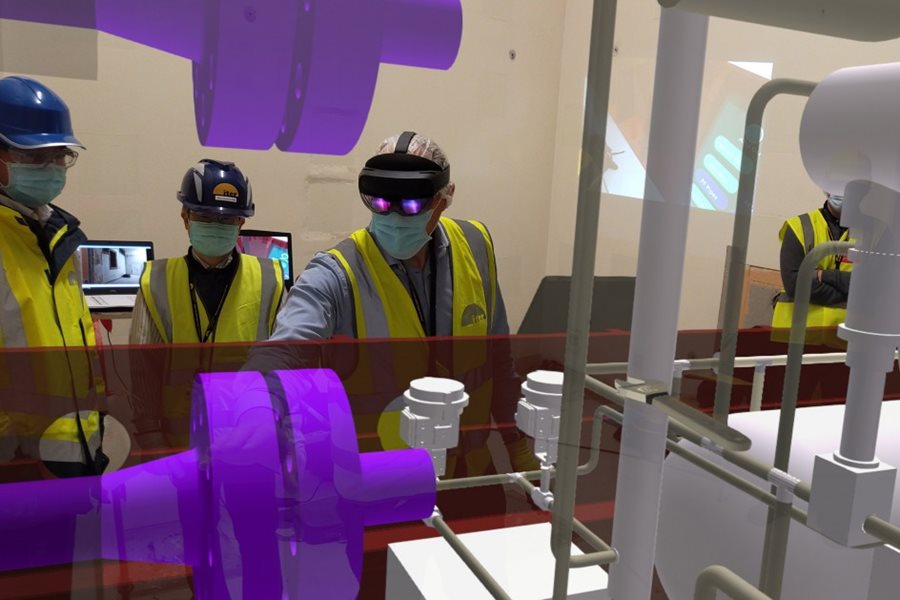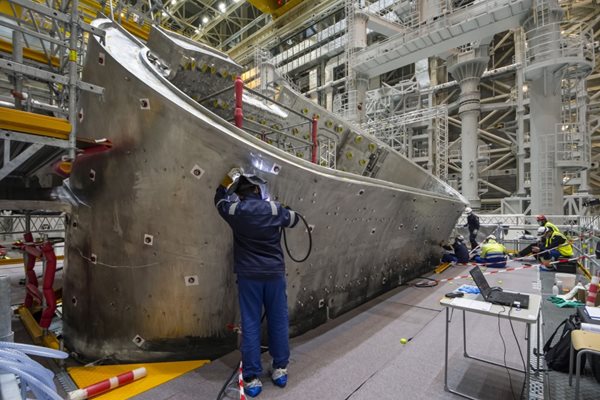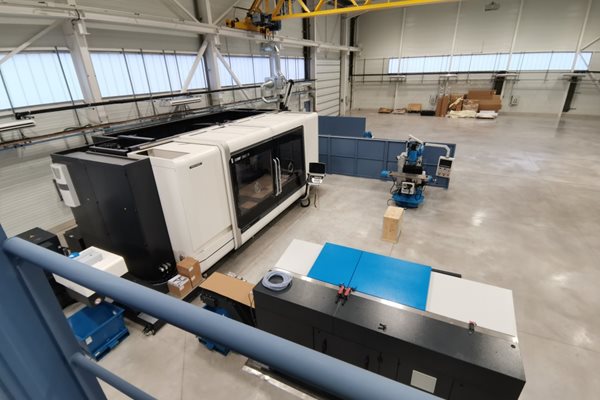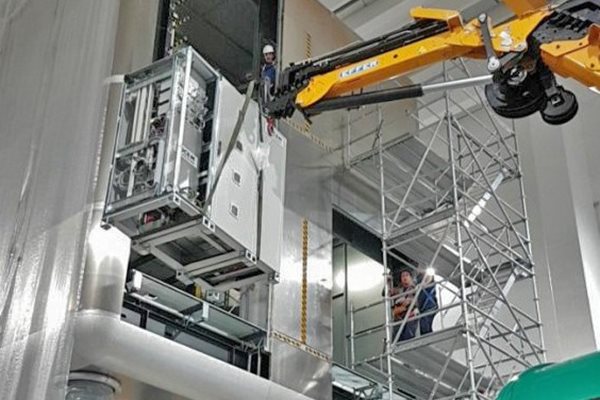
you're currently reading the news digest published from 20 Oct 2020 to 26 Oct 2020
featured4
press10
featured
Augmented reality | Assessing the future work environment
As part of their collaboration within the Site Support Agreement*, ITER and its neighbour CEA are developing a novel approach to explore, analyze and assess the work environment in the port cells dedicated to the handling of the test blanket modules. By virtually superimposing 3D models on the world as it is, "augmented reality" tools not only provide an awesome experience but they can contribute to maximizing operator efficiency while minimizing their exposure. Test blanket modules are essential to the future of fusion energy, which rests on the capacity of future industrial reactors to breed tritium—one of the two hydrogen isotopes (with deuterium) involved in the fusion reaction. While tritium occurs naturally only in trace amounts, a certain type of fission reactor (CANDU) generates minute quantities of tritium that accumulate into a global inventory that hovers around a few dozen kilograms. Over its years of full-power operation, ITER will consume the totality of the tritium available worldwide, but will also prepare for the future by implementing experimental "tritium-breeding modules." Two pairs of test blanket modules, developed and procured by the ITER Members and each implementing a specific technology, will be embedded into the inner wall of the vacuum vessel. Although the active, plasma-facing element of each breeding module is a relatively small component (1.7 metres tall and 60 centimetres wide), they are part of a much larger structure that weighs close to 45 tonnes. Every other year, during shut down, two massive structures (each holding two test blanket modules), will need to be extracted so that the plasma-facing elements can be submitted to in-depth analysis. At Level 1 of the Tokamak Building, which corresponds to the equatorial region of the machine, two "ports" are dedicated to the handling of test blanket systems and will be used as entry and exit passages for the 45-tonne components. Today they are empty, but when the machine is operational they will be crowded with a forest of pipes, ducts, rails and systems of all kinds. Although most of the handling operations will be performed automatically and remotely, human intervention will be required at some points. But as the ports stand close to the machine and will have been exposed to burning plasmas for several months, the presence of duly equipped operators will have to be limited and their exposure time reduced to a minimum. The test blanket systems, which will be installed a few years before full-power operation begins, are presently in the preliminary design phase. "We have drawings, we have 3D models, but in order to optimize our approach, we need more," explains Jean-Pierre Martins, the maintenance engineer in the ITER Tritium Breeding Blanket System section. The "more" is a novel approach developed by CEA experts and called "augmented" or "extended" reality. It feeds from 3D databases to create an "in-context" immersion, blending and superimposing virtual and 'real' elements such as doors, walls and galleries. System designers, experts and decision makers—each wearing a state-of-art headset (such as Microsoft HoloLens)—can participate in the same simulation, exploring the physical configuration of the projected port cell environment and sharing a common understanding of the working configuration and conditions. The experience is awesome: through the hologram that is projected onto the eye's retinae, the operators are walking through the densely packed environment of that port cell as it is planned and experiencing the challenges that they will encounter. Understanding the constraints that the environment will impose is essential to optimizing their interventions. "We are aiming for maximum efficiency and minimum exposure, in line with the ALARA principle (As Low As Reasonably Achievable) that governs radiation exposure in nuclear environments," says Martins. "In this perspective, when implemented at the early phase of a system's design augmented reality is an extremely promising tool. Beyond its application to the test blanket module system, it can be propagated to the entire project." These past weeks the ITER Director-General, the Heads of Domain, and several managers have donned the magic headset, ventured into the strange world where real and virtual blend, and taken the full measure of augmented reality's potential in planning for the future. Click here to view a video of the trials. * Signed in 2009, the Site Support Agreement establishes and defines the relationship between the ITER Organization, the French Commissariat à l'énergie atomique et aux énergies alternatives (CEA) and Agence Iter-France.
Diagnostics and instrumentation | First welding on the vacuum vessel
Beginning in 2035, ITER will open a window into "burning plasmas"—a state of matter that exists in the core of stars only. Observing, assessing and monitoring this yet unexplored territory of physics will require a vast array of measuring systems and diagnostics. In the Assembly Hall, welding specialists are taking the first steps toward their physical installation on the vacuum vessel.Like an elephant at rest, the first of the nine vacuum vessel segments lies on its side at the far end of the vast and crowded hall. Its grey skin, which was perfectly smooth when the component was delivered in late July, is now pockmarked with dozens of small cylindrical devices, some perfectly aligned, others distributed in a seemingly haphazard fashion. Alex Martin, who heads the ITER Vacuum Vessel Section, uses another image—what he sees in this scene is "a stranded whale, its skin colonized by barnacles..."The number of cylindrical devices (or barnacles if you prefer) is growing by the day: since work began last Wednesday, close to 150 of these objects, called "bosses," have been welded to the component's outer surface and the total should reach over 700 within a few weeks.Bosses are like studs onto which other components can be bolted or welded to the vacuum vessel. They are designed to support the instrumentation that monitors the main electromagnetic parametres of the plasma—the shape of its boundary along with other data. Bosses are also used to support the cable trays that guide the sensors and instrumentation cables away from the vacuum vessel, along the vacuum vessel wall, through the cryostat, the bioshield, and eventually to the control cubicles and electronics located in the Diagnostic Building. Welding 700 studs to a steel surface may appear to be a simple, repetitive operation. It is not. "We are dealing with the first confinement barrier of a nuclear device," explains Alex, "and in order to ensure its integrity we have to observe a whole set of procedures that are controlled by nuclear safety, quality and third party nuclear inspectors."The precise positioning of the bosses on the curved surface of the vacuum vessel sector is achieved using an innovative technique called "laser templating." Drawing from 3D models of the vacuum vessel and diagnostics, a laser beamer projects the outline of the element to be welded at its precise pre-defined position on the component's surface, providing the welder with a perfect template. It is the first time that laser templating has been implemented on ITER for such an application.Identical operations will be repeated on the exterior walls of the eight other vacuum vessel sectors prior to pre-assembly. As for the equipment planned on the inner walls, it will be installed once the vacuum vessel pre-assemblies are inside the Tokamak pit. In total, 30,000 welded attachments, fitted to within a few millimetres of tolerance, need to be welded to the vacuum vessel.
Assembly | Machining workshop opens on site
Construction of an on-site machining workshop began in December 2019 and was completed on schedule in September 2020.The new workshop will be operated by the DYNAMIC consortium, which was formed to execute one of ITER's two main machine assembly contracts, TAC2 (Tokamak Assembly Contract 2). The consortium reunites Ansaldo Nucleare, Endel Engie, Orys Group ORTEC, SIMIC, Ansaldo Energia, and Leading Metal Mechanic Solutions SL.TAC2 scope includes complex lifting, positioning, welding and inspection tasks for ITER's toroidal field coils, vacuum vessel sectors, thermal shields and ports. Initial work will take place in the Assembly Hall, before the bulk of the effort is moved to the central Tokamak pit.Finishing touches on siteThe new workshop includes two milling machines (one vertical and one horizontal) and a large CNC (Computer Numeric Control) machine that operates along three dimensions to produce 3D parts. A work area is set aside for welding, with a smoke exhaust and a welding table. A special room is dedicated to metrology, so temperature and humidity can be controlled to avoid skewed measurements. In addition to the shared spaces, the structure includes offices for area managers of the companies in the DYNAMIC consortium.'Primarily, the workshop will be a space for repairs and retrofitting,' says Nicolas Vendeuvre, Contract Responsible Officer for TAC2. 'We cannot always do these things directly in the Assembly Hall or in the pit. So part of the work will be done in this new machining workshop.''We retrofit by taking measurements just before the direct assembly of the components in the Tokamak pit, or in the sector sub-assembly tool in the Assembly Hall. Retrofitting is required, for example, when you try to assemble two components and there is a gap. You need to machine the third piece, called a shim, to fit the exact gap and this is not something you can do before assembly.'Shims will be used for mechanical parts, but they will also be used to make corrections on concrete structures, which are even more prone to misalignment. 'Concrete expands and shrinks more than the metal,' says Vendeuvre. 'And pouring concrete cannot be done within the same final tolerance as you would get with very precise machining operation. The tolerance for placing concrete is +/- 10 mm. But for mechanical parts, and especially for the assembly we need to do in the tokamak, we need much lower tolerances—less than 1 mm sometimes.'Other adjustments can be made in the workshop. Raw materials are often delivered with extra lengths and must be cut at the exact right dimension, as measured on site. It may also be necessary to enlarge holes on one part to connect to one or more other parts. And some pre-assembly will be performed at the workshop—for example, pieces of pipe can be assembled in the workshop before bringing them to the final assembly site.'The workshop will also be used to build light tools or structures used to support components, pre-assembly works or structures,' adds Vendeuvre.Distance has always been a driving force'One of our goals was to avoid transporting components off site to the workshops of consortium members,' says Vendeuvre, 'especially since the nearest is 80 km away from ITER. Having the workshop onsite allows us to avoid the risk of damaging components during transportation and it also saves time and money. This is why the ITER Organization included the onsite workshop as a project requirement.'The 2,000 m² workshop will be operated by DYNAMIC, with around ten people in the workshop at a time.
Neutral Beam Test Facility | Power is ready for the prototype injector
The European Domestic Agency has carried out successful site acceptance tests at the ITER Neutral Beam Test Facility on power supply equipment installed overhead in the spectacular high voltage deck—a Faraday cage box measuring 12 x 8 x 9 metres.Standing on eight legs, the high-voltage deck is an electrically insulated box that contains transformers, power distribution systems, converters and control cubicles weighing approximately 50 tonnes for the MITICA* neutral beam injector's ion source. The role of the high voltage deck is to isolate the power supplies of the ion source from the ground. The European Domestic Agency for ITER, Fusion for Energy, procured both the high voltage deck (through Siemens) and the equipment inside it—the ion source and extraction power supplies (ISEPS) through OCEM Power Electronics. ISEPS consists of eight power supplies and auxiliaries producing 5 MVA in total. Installation was completed in October 2019, but the site acceptance tests initiated early this year had to be postponed due to COVID-19. The final tests took place in September 2020, and were transmitted live to those not able to be present.*MITICA (for Megavolt ITER Injector and Concept Advancement) is a full-size prototype of ITER's 1 MV heating neutral beam injectors. Capable of full acceleration voltage and power, it is scheduled to begin operating in 2022 at the ITER Neutral Beam Test Facility to test all physics and technology issues and validate concepts before the neutral beam system is installed on ITER.See the full report on the successful tests on Fusion for Energy's website.



